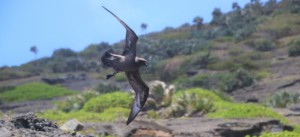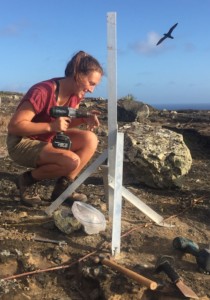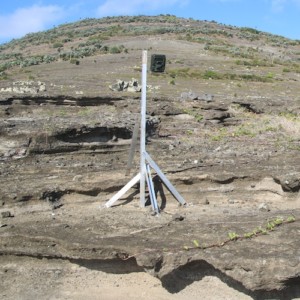Mauritius was made first and then heaven, heaven being copied after Mauritius
With such a recommendation from Mark Twain, it is no surprise that over 1.3 million tourists visit Mauritius each year. The tropical island, situated in the west Indian Ocean, is well-known as a popular holiday destination, with its clear blue waters, white sandy beaches and volcanic mountain backdrops. However, I am not here to tell you about my time sat on the beaches of mainland Mauritius (although they are pretty spectacular!), but rather a small volcanic islet called Round Island, situated 22.5 km off its northern coast.
Round Island was created by an active volcano between 250,000 and 100,000 years ago; its rocky cliff faces are made up of layers of compressed ash, interspersed with bits of old coral and lines of quartz. The island’s remoteness and steep rocky cliffs have made it a difficult place to access and, as a result, the island was unappealing for human settlement. This means that relatively few people have visited the island – a huge advantage for the island’s wild inhabitants, given the devastation that often accompanies human habitation of islands. Mammalian predators, such as cats and rats, have never reached Round Island, as they did mainland Mauritius. Goats and rabbits were introduced, to provide food, but these have been eradicated. The damage they caused to the vegetation is now being restored by the Mauritian Wildlife Foundation and the National Parks and Conservation Service (Mauritian Government).

As soon as you reach the island (after extensive quarantining procedures, a motion sickness-inducing boat ride, and then an assisted jump off the boat onto the only flat rock along the island’s coastline), all you can hear is the cacophony of seabird calls. Dawn and dusk are alive with the rapidly repeating and high-pitched call of the Round Island petrel, aggressive Red- and White- tailed tropicbirds fill the remaining daytime hours, and the night is filled with the eerie calls of Wedge-tailed Shearwaters. It is the Round Island petrel which I travelled to Round Island to study in September 2019. You can find out more about this unique Pterodroma population in my last BOU blog post.

Pterodroma petrels can be found on Round Island at any time, although the numbers in which they occur fluctuates across the year. This relates to a peak in the breeding period from August through to October. Round Island wardens, staff and volunteers monitor the breeding effort of these petrels every two months during routine petrel surveys, and I had the pleasure of helping during my time on the island. Known nesting areas are visited and petrels are either ringed or recorded as recaptures. At the same time, breeding status (including number of eggs, chicks and fledglings) is recorded. The petrels are surface-nesters so ninja-mode has to be employed in order to sneak up on the adult birds before they see you and fly away. Preliminary analyses of the long-term survey data (collected since 1994) have revealed seasonal variation in breeding success but further detailed data and analyses are required to understand why this pattern occurs.
I could have spent my time on Round Island visiting nest sites every day, in order to try to measure individual petrel breeding performance and capture this seasonal variation in nesting success, but I needed a longer-term solution for monitoring these enigmatic seabirds. So, instead, I spent my two months on the island trialling the use of time-lapse photography. This method has the advantage that, once installed, there would be reduced disturbance at nests, and nest sites could be monitored year-round. I spent my first week on Round Island checking out the different petrel colonies and looking for potential camera sites. This gave me the opportunity to explore the island, watching every step in order to avoid treading on the abundance of native and endemic reptiles scampering about underfoot, whilst getting used to the very steep and rocky terrain.
Round Island petrels nest in a variety of different habitats, typically in rock cavities or under rock ledges but they may also nest among boulder piles, tussock grasses, under Scaevola bushes, or just out in the open. Let’s just say, finding potential camera sites (where the contents of multiple nests could be viewed, to increase sample size, while avoiding direct sunlight on the camera face) wasn’t the easiest of jobs. To help me in my efforts, I also used the historical productivity data collated from the routine petrel surveys, so that I could choose nest sites that had been used relatively frequently in the past few years, in the hope that they would be used again.
To make things even more interesting, Round
 Island experiences a very seasonal environment with a tropical cyclone period during the austral summer. This meant that cameras needed to be securely fixed to the ground, and the materials sourced to make the stands have to be able to withstand high levels of salt and moisture. After trialling stand designs and overcoming the logistic challenges of getting stainless steel and aluminium poles onto the island via boat, it was time to build. I knew when I started my PhD that I would gain new skills, but never did I think it would be in DIY! Each camera is attached by a metal bracket to a vertical metal pole dug into the rock, and supported by four additional metal bars, each drilled into the rock; all cut to size depending on the camera’s location.
Island experiences a very seasonal environment with a tropical cyclone period during the austral summer. This meant that cameras needed to be securely fixed to the ground, and the materials sourced to make the stands have to be able to withstand high levels of salt and moisture. After trialling stand designs and overcoming the logistic challenges of getting stainless steel and aluminium poles onto the island via boat, it was time to build. I knew when I started my PhD that I would gain new skills, but never did I think it would be in DIY! Each camera is attached by a metal bracket to a vertical metal pole dug into the rock, and supported by four additional metal bars, each drilled into the rock; all cut to size depending on the camera’s location.
Above, Kirsty installing a camera trap and below, a finished trap in situ
A range of camera settings were tested: did I
 want the PIR motion sensor on? How often did I want a photo to be taken? These options would determine how often camera maintenance would have to take place (changing batteries and SD cards). I opted for time-lapse only taking one image every hour, which should allow the identification of key phenological dates (e.g. egg-laying, hatching, chick fledging) and the recording of nest attendance, and finally nest success. To capture the seasonal variation in breeding success, the idea is that the cameras will be left in the field to take photos for the duration of my PhD (2019-2021). Camera maintenance will take place at two-month intervals to coincide with the routine petrel survey, and photos will be emailed back when the Internet allows. Now I have to wait, but I’m itching to see the many images of up to 40 nests that the ten cameras reveal!
want the PIR motion sensor on? How often did I want a photo to be taken? These options would determine how often camera maintenance would have to take place (changing batteries and SD cards). I opted for time-lapse only taking one image every hour, which should allow the identification of key phenological dates (e.g. egg-laying, hatching, chick fledging) and the recording of nest attendance, and finally nest success. To capture the seasonal variation in breeding success, the idea is that the cameras will be left in the field to take photos for the duration of my PhD (2019-2021). Camera maintenance will take place at two-month intervals to coincide with the routine petrel survey, and photos will be emailed back when the Internet allows. Now I have to wait, but I’m itching to see the many images of up to 40 nests that the ten cameras reveal!
I wish to thank everyone involved in the project and providing access to Round Island: Mauritian Wildlife Foundation, National Parks and Conservation Service, my wonderful supervisors (Jenny Gill and Simon Butler from University of East Anglia, Malcolm Nicoll and Ken Norris from Zoological Society of London, and Norman Ratcliffe from British Antarctic Survey) and in particular, Round Island warden Johannes Chambon and fellow PhD student Max Tercel for their invaluable help in the field.
Image credits
Featured image: Round Island petrel Pterodroma sp © Malcolm Nicoll




